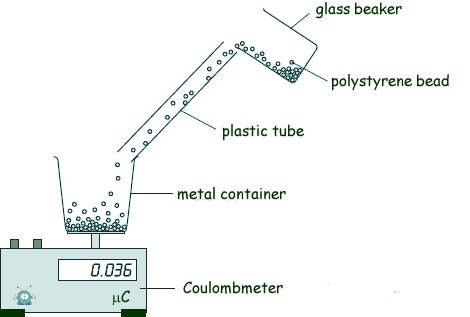GCSE Questions: Static Electricity
Q6.
(a) Fine powders poured through a pipe can collect a charge.
A student carries out an experiment to investigate this effect.

The student pours 75 cm3 of polystyrene beads down the pipe. The beads fall into a metal can and the charge on them can then be measured directly using a coulombmeter. The coulomb meter measures the charge in microcoulombs.
1.0 C = 1,000,000 µ C
The student repeats this procedure twice more, but each time uses 75 cm3 of beads of a different size.
(i) When they fell through the pipe, the polystyrene beads became negatively charged. Explain how this happened.
(3 marks)
(ii) Give one control variable in the student's investigation.
(1 mark)
(b) The results obtained by the student are shown in the table.
Diameter of polystyrene beads /mm |
Charge / µ C |
1.0 |
0.080 |
2.0 |
0.044 |
3.0 |
0.012 |
(i) Describe the connection between the size of the polystyrene beads and the total charge on the beads.
(1 mark)
(ii) Explain how these results might be different if the student had used a shorter pipe.
(2 marks)
(c) In industry, powders are often pumped through pipes. If the static charge caused a spark, the powder could ignite and cause an explosion.
(i) Is an explosion more likely to happen when pumping very fine powders or when pumping powders that consist of much larger particles?
Give a reason for your answer.
(1 mark)
(ii) Suggest one way that the risk of an explosion could be reduced.
(1 mark)
(d) The table gives the minimum ignition energy (MIE) value for a number of fine powders. The MIE is the minimum amount of energy required to cause a fine powder to ignite.
Type of powder |
MIE /mJ |
Coal dust |
60.00 |
Aluminium powder |
10.00 |
Cornstarch dust |
0.30 |
Iron powder |
0.12 |
The MIE values for different substances are all measured in the same way and under the same conditions of pressure and temperature. Why is this important?
(1 mark)
[Total 10 marks]



